Stops and Starts: Exploring the Impact of Delays on Single Issue Comics
I remember exactly where I was when I first read the debut issue of Nate Simpson’s Image Comics series Nonplayer. I was on a bus in Australia taking me from Brisbane to Noosa, a small surf community on the Sunshine Coast. The site I was writing for at the time, Multiversity Comics, had received an advance review copy, and our editor-in-chief Matthew Meylikhov sent an email hyping it up. It was the real deal, he suggested, so before the bus took off, I downloaded the PDF onto my iPad so I could read it in transit. Nonplayer #1 absolutely blew me away, with Simpson’s art and the inventive, engaging story sucking me in instantaneously. That was in March of 2011, a month before its release.
The next issue of that title arrived in June of 2015, the month I launched the original iteration of SKTCHD. I loved the second issue as well, and after having Simpson on Off Panel, I was hopeful to someday see the conclusion to this series, even if it would take a while. I’m still waiting, as there’s been no indication that a third issue is coming over four years later.

While delays like that are extreme, any lapse in schedule can generate consternation amongst a fan base. When it stretches even further, frustration can mount. That’s not to say the average title doesn’t have legitimate reasons for delays. They almost universally do, from health problems to any number of life or creative roadblocks. But conversely, it’s understandable that readers feel as they do. The frustration is an extension of their passion, as emotions with stories get tangled up together. Whatever the reasoning on each side, it’s a complicated relationship, and one that doesn’t seem conducive to the long-term health of a title. After all, delays kill comics, right? I’ve heard that a million times, and it’s an accepted truth within comics, I feel.
But is it true? Here’s a quick example to illustrate how murky and inconsistent the impact of delays really can be:
- Nonplayer #1: 8,869 copies ordered 1
- Nonplayer #2: 13,507 copies ordered
That’s weird, right? That’s more than an additional 1,000 copies ordered for each year the title was absent. One example does not make a trend, though, and frankly, Nonplayer’s length of delay was so extensive that each issue dropped during wildly different times in the direct market, at least from a health perspective. It’s so unusual it’s a complete outlier. This does show, however, that there’s no single answer to how the market responds to a variable like release schedule. But maybe given a little exploration, perhaps we could see a little bit more of a trend. So with that in mind, I’m going to examine the following question: Are single-issue comic orders significantly affected by delays? Let’s see what we can find out.
Before we get into the data, I wanted to establish some ground rules about how I approached this, what you can take away from it, and other things of that sort.
First, here’s how I determined what a “regular” comic was versus a “delayed” title. It’s simple. A regular title is one that either follows at least a monthly schedule for a Marvel or DC title 2 or some predictable variation of the “Saga Schedule” that Image’s titles employ. For those that don’t know, that schedule is effectively this: release an arc, take a three month or so gap during which your trade drops, then the series comes back. A delayed title is one that sees inconsistent releases of either in-arc issues or significantly larger than usual gaps between arc endings and beginnings. 3 That’s the line in the sand.
Second, I both tracked order data for notable delayed titles as well as a random selection of comparable regular titles, 4 with the latter operating as context for the former. I matched the distribution of titles per publisher on both. 5 Keep in mind, though. While I tried to track a comparable mix of titles, this is not the equivalent of anywhere near any sort of standard attrition rate. That will vary dramatically by publisher and title, and you’d need considerably more inputs to come up with a universal number.
Third, I primarily focused on three publishers – DC, Image and Marvel – because they are the only ones that generate enough scale to be able to see a realistic impact. However, my focus on Marvel was limited, as I came to realize pretty quickly that Marvel is militant about its scheduling and almost never misses a beat. I also only focused on titles from the past six years or so to make sure we’re dealing with roughly the same market conditions.
Fourth, as noted before, all data comes from Comichron, and my information is all based off estimates they’ve created and vetted. I’m not focusing on order numbers really, anyways, instead zeroing in on average attrition rate. 6 Also, I’m only looking at the numbers from issue #3 and beyond, as that gives each title a little time to find their respective levels, even if it doesn’t get all the way there.
Lastly, keep in mind that as much as we want to make definitive calls based off data, there are a whole lot more variables that impact a comic beyond just frequency of release. As much as I’d like to make definitive statements off what I discovered during this exercise, there’s a whole lot more that could impact order fluctuation, some of which will be addressed in this piece. That’s enough preamble, though. Onto the charts!
Like I said above, I wanted some context for the delayed numbers. We can’t know if delays are impacting sales unless we know a little bit about what typical behavior looks like. So let’s start with a chart of ten titles from DC, Marvel and Image that have managed to keep a schedule, looking at average attrition rate on an issue-by-issue basis for each of them.
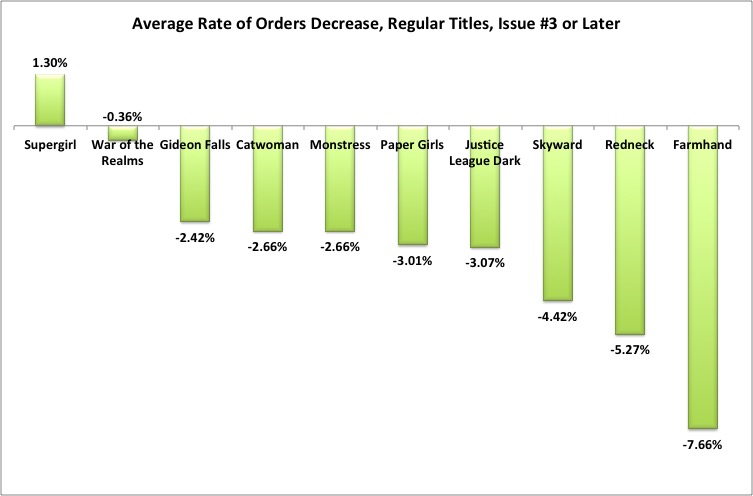
You actually see Supergirl with an increase of orders on average on the high end of the spectrum for this family of titles, as its data has been skewed by some hearty spikes in the middle to back half of its 32 issue run. 7 On the low end, you have Rob Guillory’s Farmhand, an Image title that’s now ten issues deep. Nothing catastrophic here, but the middle titles certainly provide a better feel for what regular attrition looks like as a comic gets further into its run.
Okay, then. Let’s look at titles that have seen delays, with a similar ten title mix of DC, Marvel and Image comics.
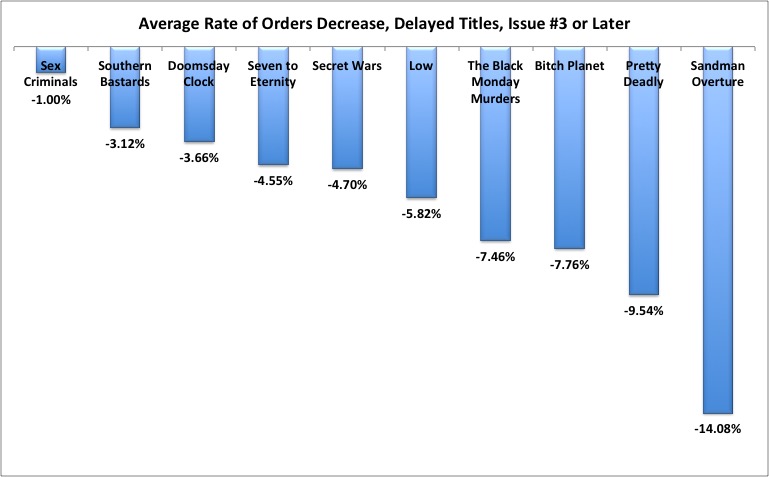
Another wild spectrum here, ranging from an average attrition rate of 1% for Sex Criminals to the clear leader of the pack in The Sandman: Overture, which saw its orders decrease at a rate of over 14% after its third issue. Overall, though, the rate of decrease appears to be much higher for these titles than they were for the regular issues, which is worth noting from a micro, title-by-title basis. I did want to address a few specific titles before getting into a more macro look, though, as that micro focus does seemingly reveal some attrition based trends. And what better place to start with than our clubhouse leader in The Sandman: Overture?
It might seem surprising to see such a significant title leading the way here, but there are a couple important things to consider about why this title saw such a substantial decrease on average. The first is related to something a retailer told me when I quizzed them on this subject, and that’s that delays often have less of an impact when a title is a fair bit into its run. If its delays start with issue #12, it’s unfortunate, but it can also be less painful. You have an established audience for the series at that point, and they’re more likely to come back because of it. The Sandman: Overture was late from the jump, as its second issue arrived five months after its first. Not a great start, and it’s a cadence it more or less continued, with the series completing its six issue stint in 24 months.

One quick note on that: yes, Sandman had an established audience, but it had been 17 years since the final issue of the initial series dropped. It’s a book with an audience used to trades and other collections. Buying individual issues was irregular behavior for them.
The second and most notable reason for the title’s monster attrition is tied into that idea. One shop told me that the first issue of this series generated a significant amount of new customers for their store – more than 100 people who hadn’t bought comics in years came in for Gaiman – and when they bought the first, they asked when issue #2 was coming. These customers returned when issue #2 was meant to drop, but it wasn’t there. The customers asked for a new date, and when they returned again and it still had not arrived, more than 90% of these new customers never came back. Not ideal.
That’s one of the biggest takeaways here. Delays nuke the interest of non-regular customers, as they’re likely to either switch to trade or just forget the comic ever existed.
Quick aside before we move on, though. One quirk I wanted to look at was how a regular release schedule affects a normal title versus one that’s insanely delayed like The Sandman: Overture. To study that, I looked at another series that launched the same month as Overture at a very similar level: Superman/Wonder Woman. Each debuted in October 2013, with Overture landing with an estimated 93,301 copies ordered and the Supes/WW title arriving with 94,859. When Overture ended with its sixth issue in September of 2015, it had 48,553 copies ordered. That same month, Superman/Wonder Woman’s 21st issue dropped and had 34,349 copies ordered. The title that maintained a regular schedule actually saw a much bigger decline over that timeframe.
That’s not ultimately super meaningful, as one was an event comic while the other was a rather superfluous and arguably forced team-up book that managed to deliver 15 more issues. But it is interesting that the one that maintained a regular schedule decreased by a greater amount of copies ordered over that span than the one that didn’t, if only because it had a more established pattern of not selling. 8

The next title I wanted to look at is Doomsday Clock, the DC title from Geoff Johns and Gary Frank that has been fusing the regular DC universe with Alan Moore and Dave Gibbons’ Watchmen for a little under two years now. It has just ten issues to show for it. Its next issue has been pushed back to September, with its 12th and final issue not even currently being solicited. It’s an interesting title if only for one reason: its rate of attrition hasn’t really been that bad at all. It has decreased at about the same rate as Justice League Dark, a regularly released title with a notable name and relationship with one of DC’s flagship titles, but also one lacking the heat of Doomsday Clock.
That ties back into the idea I mentioned with The Sandman: Overture, or at least the flipside of it. While non-regular customers do not wait, regular customers often do. The audience for a Geoff Johns written, DC-meets-Watchmen series is about as regular a group as you can find. According to retailers I spoke with, they wait for this title, even if shops also wonder how much more the title would sell if it could follow a predictable schedule.
One shop even suggested to me that the delays helped Doomsday Clock get more readers, as the stretched schedule led to more readers discovering it and jumping onboard. 9 Pair that with DC keeping previous issues in stock and you have the recipe for not just regular readers sticking around, but other readers jumping on later on in its run.
This is where an interesting idea started to form. When you look at two of the titles least affected by delays, you find two event comics in Doomsday Clock and Secret Wars. 10 Meanwhile, indie comics tend to get affected in a completely different way, with one shop saying a publisher like Vault is deeply harmed when a title falls off schedule in a way Marvel or DC isn’t. 11 Image is in the same boat as indie publishers, even if they might be on a different level than their peers from an awareness standpoint.

One shop had an interesting anecdote about an Image title I tracked above: Bitch Planet. In this shop, delays don’t inherently impact their orders. Instead, they wait until delays affect sales and then adjust accordingly. With something like Kelly Sue DeConnick and Valentine De Landro’s series – which saw 10 issues of the regular title released over 2.5 years, none of which have come since April of 2017 12 – they saw sales not just drop, but readers actually turn against the title. It wasn’t just removed from pull lists. Sentiment flipped on it completely, going from something readers were passionately positive for to something they were negative about. That’s the deeper impact delays can have.
Outside of Bitch Planet, It may seem weird that so many of Image’s titles are prominently featured in the delays chart, almost as if I’m picking on them. First off, I’m not. Second off, there’s a reason so many are featured, and you could probably guess what that is. With a Marvel or DC title, if a writer or artist is delaying the release of a comic, the publishers replace them or hire a fill-in to give them space. Given that Image is a creator-owned publisher, most books aren’t going to see creators fire themselves or the person they co-created a title with. That inherently causes bottlenecks that Image has tried to prevent. They previously instituted a rule of having three issues in the can before soliciting titles in hopes of heading this off, from what I understand. The problem is delays just typically happen in the second arc or beyond then. That’s when troubles seem to hit.
Image titles can help themselves with this. One shop mentioned that if readers know there will be a delay – like with Saga or Lazarus – the issue is at least somewhat mitigated. The unknown is what causes the problem. Delays are impactful, but if there’s some level of predictability to it, it can be manageable instead of apocalyptic. 13
There are limits to that idea, though. Another shop mentioned to me the only time a delay makes them lower their orders is when an issue is over a year late, and that’s that way with any publisher, not just Image.
One last note about the delayed chart. You may notice that the comics included within it are rather notable. Each of them are significant titles with A-list creative teams. The reason I selected them is related to an above footnote, and that’s because delayed, smaller scale Image titles have a particularly tough time surviving long enough to get a decent ways into their runs, so they don’t fit my criteria well. I was primarily aiming for titles that have made it through two arcs to give each title more time to normalize, outside The Black Monday Murders, which I had to include. That creates a skew in the data to a degree, as significant titles with A-list creative teams likely earn a bit more leniency amongst readers. So these attrition rates might be lower than the ones smaller titles could see if they hit heavy delays. Just something to keep in mind.
Let’s move onto the macro scale to contextualize this subject a bit more by not just individual titles, but for the totality of the regular and delayed titles I looked at. Is there a clear divide between them? Seems like it.
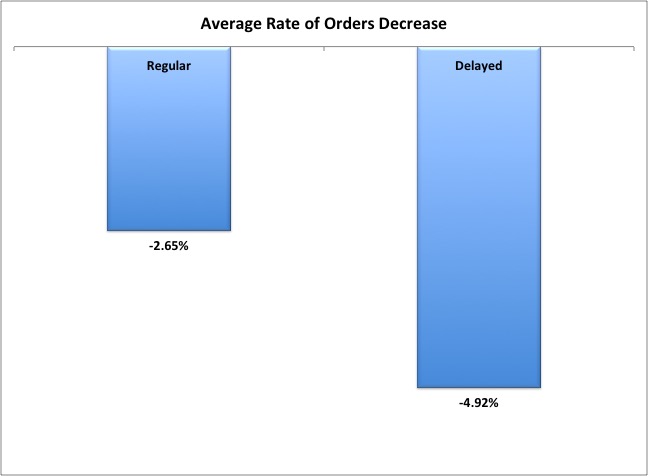
The average rate of attrition for delayed titles is much, much higher than those that follow a regular schedule – it’s a nearly 86% lift in attrition rate – so it sure looks like there is a divide here, even if this isn’t a reflection of a massive amount of titles. Seems like that makes it clear-cut, right? Delays are hugely impactful in terms of how comics are ordered. That’s that. Article done!
Not quite. I mentioned earlier in my preamble that there are other variables to consider, and there were two titles that were so obviously impacted by one of those that I had to rerun this data to provide a more apples-to-apples comparison. The comics affected are Supergirl and Sex Criminals, and the variable is everyone’s favorite order goosing mechanism: variant covers.
For Supergirl, it had the comic book equivalent of steroids on its side, and that’s covers from Stanley “Artgerm” Lau. 14 It turns out he’s rather popular and affects orders to a degree that makes issues featuring his covers complete outliers relative to the rest of the series. For the following charts, I removed every issue that had a variant from him or a regular cover, as well as the issue that followed those ones, as they had an attrition rate that was just stupid because of it. Note: I did the same thing for a couple Artgerm-blessed issues of Catwoman, as well, but this was mostly a Supergirl focused trend. 15
For Sex Criminals, they started rolling out polybagged XXX variants with issue #11 that were slightly more expensive 16 and were very much speaking to their audience. However, because these variants were particularly effective – the first issue to have one saw an almost 60% increase in total orders – and because they likely speak to the same audience, just in a different way, I decided to exclude them on these charts to be more consistent.
These aren’t the only titles that had variants, of course. But there are regular variants and there are ones that destroy any idea as to how these comics actually sell. I excluded the latter. Here’s the regularly released titles again, minus Artgerm.
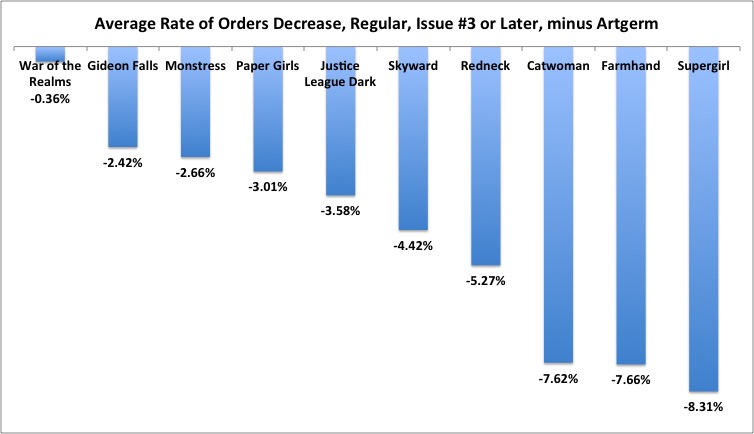
Supergirl goes from the best performing title in terms of attrition rate to the worst just by subtracting Artgerm’s covers, while Catwoman sees its attrition rate nearly triple. Okay, then. Good job by you, Artgerm! Let’s look at the delayed titles now, with updated numbers for Sex Criminals.
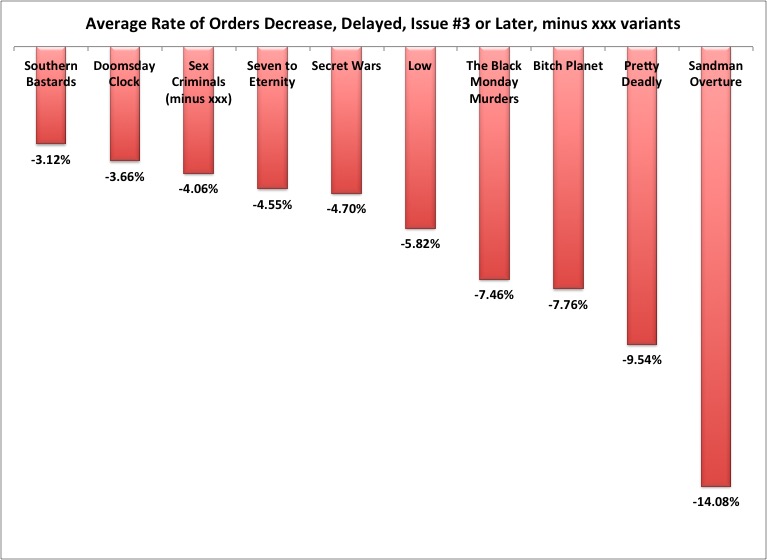
Sex Criminals goes from the best performer to third best, but its attrition rate more than quadrupled. That’s a lot, although the title still has done well with delays. Those XXX variants do make a significant difference. Free idea to Team Sex Crimz, though: get Artgerm to do a XXX variant. Then retire forever. You’re welcome.
Last chart time! It’s time for the macro look again, minus those outlier variants.
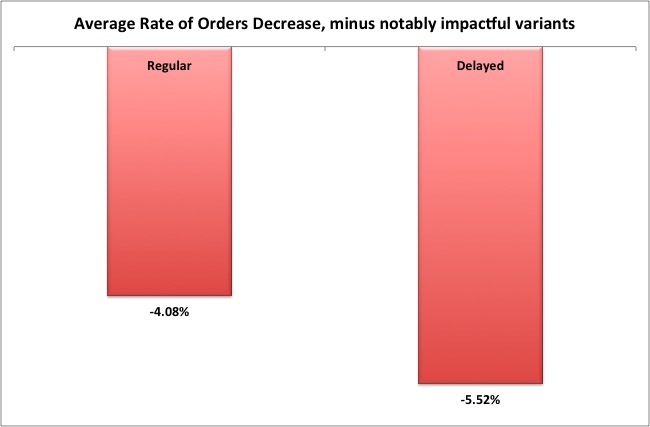
The gap between regularly released titles and delayed ones was 2.27% on average before. It’s now just 1.44%. If you subtract The Sandman: Overture – you might do that because it’s by far the biggest outlier in the data, as well as the most difficult title to find a comp for – that gap shrinks even further, as they are then separated by just 1.14%. That’s still a difference of over 35%, which is significant but also much less than it looked before. Delays go from a clearly big deal to much less of one if you just subtract out the variants that skew the data and a title that doesn’t jive with the others. Interesting.
If you’re hoping for a capital T Take from me on this subject, you’re likely new here. That’s not my style, especially on a subject like this and without many, many more inputs from a broader selection of titles. If you want one, here’s the best I’ll give you: I believe delays do have an impact on orders and sales on average, and it’s an impact that ranges wildly depending on the store, the customer, the title and the publisher. I mean, it’s hard not to notice that the most well liked titles from the most popular creative teams – i.e. Gideon Falls, Monstress, Southern Bastards, Sex Criminals and Paper Girls – and the event comics are the ones that see the least attrition, regardless of release frequency. So there’s more at play here than just release schedule, 17 which makes tracking the impact of delays noisy at best. But I will say I believe delays have an impact, and the significance of said impact is dependent on those other variables.
For example, the longer a series runs on schedule to start, the more likely it will feel less of an impact. That seems likely to be true, both from a data standpoint and anecdotally. A good example of that is The Wicked + The Divine, an Image title that has seen a little schedule drift as it nears its end, 18 but one that saw effectively zero attrition on orders for its most recent issue because of it. 19 Indie comics and titles that attract non-regular customers seem to be hit the hardest, as Marvel and DC have a more reliable, resilient audience that mostly returns after delays. Anecdotally speaking, known schedule breaks help mitigate delay related attrition while unannounced ones can deeply affect a title. So transparency is key if you’re a creator with a title facing schedule crunch. These are takeaways I’m comfortable in saying “I believe these are true” based off what I’ve looked at.

One title will provide a very interesting test case of all of this, or at least it will at some point. The last time we saw Saga was when its 54th issue dropped on July 25th of 2018. We’re over a year into its announced hiatus, with no end in sight as of right now. 20 It is a test of all three of the ideas that I’ve accepted as true from this exercise, as it’s a title that didn’t see delays until well into its run, it’s one that attracts a fair few non-regular customers, 21 and it’s one that we knew would have at least a year break in its publishing schedule going into it. How Saga is ordered when its 55th issue is solicited will both provide an unbelievable test for the ordering skills of comic shops and give us insight into just how impactful delays really are. If Saga sees a hit, no one is safe.
That will be an interesting one to watch, as will the return of Kelly Sue DeConnick and Emma Rios’ Pretty Deadly, as it sees a new mini-series, The Rat, launch in September after a three plus year gap. If Saga exists as a title that should be relatively impervious to the impact of delays, at least in theory, Pretty Deadly could be the opposite. It doesn’t really fit within any of the protected variables I noted. It could face a very tough time unless the impact of trade sales has led to an unexpected growth in pre-orders for The Rat.
Because of those two titles and market trends leading to changing customer behavior, 22 this is likely a subject that will be revisited and maybe even expanded upon in the future here on SKTCHD. But for now, I’ll leave with an answer to my question at the beginning: Are single-issue comic orders significantly affected by delays? The short version is, of course, they can be. But going in, I expected to see them to have a much greater impact. As noted before, it was an idea that felt generally accepted. Delays kill comics, right? In reality, though, it seems to be a variable that does have a very real impact for every delayed title, but the measure of that is highly dependent on other factors. It doesn’t appear to be the across-the-board backbreaker some might believe, at least on a case-by-case basis. That said, I certainly wouldn’t try and test that theory if I was launching a series, that’s for sure.
Header art is from Nonplayer #1, art by Nate Simpson. I still love Nonplayer, by the way, and would totally buy issue #3 if it ever returns!
Six weeks or so isn’t a big deal, but when you start hitting the 8 to 12 week gap, you make the list.↩
Unless it’s a predictable gap that is enough to be considered a trend.↩
As much as I could match titles, of course. Not every delayed title had a comparable regular one.↩
I should note, it was kind of difficult to find Image titles that followed my definition of a “regular” schedule!↩
I mean this literally. I’m just averaging the issue-by-issue attrition here to keep things as simple as possible.↩
More on what caused that spike later on.↩
In case you were wondering, Superman/Wonder Woman #6 had lower orders than The Sandman: Overture #6, so that comparison favors the delayed as well.↩
They were not thrilled to admit this.↩
Of course, War of the Realms performed far better than both of them, and it didn’t just maintain a monthly schedule, but a bi-weekly one. So there’s an impact for event books as well.↩
For example, Natasha Alterici’s Heathen slipped off schedule for unexpected health reasons, and with just two issues in 24 months, it’s hemorrhaged orders at an almost 18% clip over the past two releases, per estimates.↩
Although there have been five issues of a Bitch Planet: Triple Feature spin-off mini.↩
Although it certainly helps if it’s a bigger Image title, as it was mentioned to me that the smaller, lesser known comics get hit harder by delays than the blockbuster books at Image.↩
More on Artgerm next week.↩
I also nixed the card stock “Year of the Villain” variants from July for the DC titles, as they also skewed the numbers enough to be outliers.↩
All prices ended in 69 cents, naturally.↩
One variable that isn’t looked at here: how collection sales are affected by delays.↩
Artist Jamie McKelvie’s health has understandably impacted the schedule, which you can hear a bit about when we chatted at ECCC this year.↩
WicDiv is an interesting title for a number reasons, as it’s a very popular book in its varying collected formats. I’d love to know how many of its single issue readers that disappeared simply migrated to trades.↩
My guess? Its return is announced at New York Comic Con.↩
One retailer wondered, “So many Saga readers don’t read anything else, and they never had to wait this long before. Will they come back?” It’s a fair question.↩
For example, one shop mentioned to me that fewer and fewer customers come in every week these days, so delays are less impactful for them unless a title just disappears.↩
